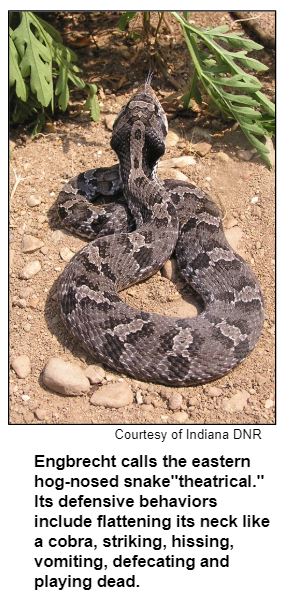Aug 7, 2020
No need to pity Indiana's snake population, but let's acknowledge that misconceptions abound about the reptiles that commonly evoke terror and scorn. Of the many species of snakes native to the state, only four are considered venomous.
Hoosier History Live will spotlight those four - including the most rare, the dreaded water moccasin (also known as the cottonmouth) - along with a range of others in the spectrum of snake species. We also will discuss a lizard that's often mistaken for a snake because it is legless.

Some tidbits about a few of the snakes that can be found on Hoosier soil (or in the water):
- Common gartersnake: Harmless to humans, it is "probably our most familiar local snake species," Nate says. Some Hoosiers call it a "gardener snake" or "garden snake."
- Water moccasin/cottonmouth: "A lot of people think they see water moccasins in Indiana, but the species is very rare," Nate says. "It has been documented at only one or two Indiana sites, and has not been verified in the state in over a decade. We have a number of non-venomous water snakes that are probably what most people are seeing." Documented sites have been in Dubois County and in Harrison County, along the Ohio River. But Nate emphasizes that only the Dubois County site is thought to still have the possibility of resident water moccasins – and the species has not even been seen there since the early 2000s. "So their current status in the state is undetermined."
- Copperheads: These venomous snakes are somewhat widespread in southern Indiana.
- Gray rat snake: Although it can be found statewide, the gray rat snake (sometimes called a "black rat snake" or, simply, a "black snake") also is most prevalent in southern Indiana.
- Eastern hog-nosed snake: It's not especially common, but can be found across Indiana, Nate says. "This is the most 'theatrical' of our snakes," he adds, noting its "elaborate defensive display that involves flattening its neck like a cobra, striking, hissing, vomiting, defecating and, in a grand finale, [it] will turn over on its back and play dead - mouth agape with tongue hanging out." Eastern hog-nosed snakes eat toads and frogs.

Glass lizards - which are found in grasslands, sandy woods and the Dunes in northwest Indiana - are so named because their tails tend to break easily when they are handled. The tails regenerate, but the replacement often is not as long as the original, Nate says.
He adds that, although glass lizards are "snake-like in appearance," they have eyelids and ear openings, features lacking in snakes found in Indiana.
Across the state, lakes, marshes, ponds, ditches and other aquatic habitats are home to the common watersnake that often is mistaken for a water moccasin. Although the common watersnake is not venomous, Nates says they tend to be "feisty when handled."
Another species that can be found statewide is the eastern milksnake. A medium-sized snake that sometimes has a brilliant red body, the eastern milksnake occasionally is discovered around farms and barns.
It is not venomous, nor is Dekay's brownsnake, which Nate describes as a small, unassuming snake that typically is gray or brown. He notes that the Dekay's brownsnake benefits gardeners by eating slugs.
Nate joined botanist Michael Homoya as a guest last November for a Hoosier History Live show about rare species of plants and animals in Indiana.